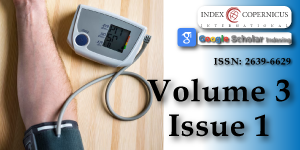Incidence of hypertension in a high-risk workgroup (Police officers) - Observational study
Main Article Content
Abstract
Introduction: Hypertension is a silent pathology in a way that affects all four spheres to be considered as such; magnitude, transcendence vulnerability, and feasibility. The World Health Organization estimates that 45% of deaths from heart disease and 51% of deaths from stroke globally are caused by hypertension.
Material and method: A longitudinal, descriptive and quantitative observational study was carried out on the personnel of high-risk public service providers.
Results: The total population sampled was 550 people where it was possible to determine the sex where the disease predominates, since 92% of the hypertensive population belong to the male sex, while 8% of the female population. 57% of the total population were classified as normotensive, while 21% were classified as High Normal, Grade I Hypertension, and Grade II Hypertension.
Discussion: AHT is the result of a series of interactions between endogenous and exogenous factors in an organism that tries to adapt to the increase of the cardiac output and the peripheral resistance of the blood vessels, which is manifested by the increase in blood pressure figures. Physical activity has been shown to have a lower risk of hypertension compared to sedentary individuals. The daily stress these workers face predisposes them to suffer their manifestations as headache, muscle pain, fatigue, digestive disorders and constant elevations of blood pressure.
Article Details
Copyright (c) 2019 Arredondo GP.

This work is licensed under a Creative Commons Attribution 4.0 International License.
Organización Mundial de la Salud. Información General sobre Hipertensión Arterial en el Mundo. Día Mundial de la Salud. 2013; 1-40.
Organización Panamericana de la Salud. Prevención, Detección, Evaluación y Tratamiento de la Hipertensión Arterial. OPS. 2008; 1-22.
Secretaria de Salud. Guide to Clinical Diagnostic Practice and Treatment of Arterial Hypertension in the First Level of Care. Quick Reference Guide. Catálogo Maestro de Guías de Práctica Clínica: IMSS-076-08. 2014; 3-21.
Instituto Mexicano del Seguro Social. Diagnosis and Treatment of Arterial Hypertension in the First Level of Care. Evidence and Recommendations. Catálogo Maestro de Guías de Práctica Clínica: IMSS-076-08. 2014; 1-77.
Ezekwesili CN, Ononamadu CJ, Onyeukwu OF, Mefoh NC. Epidemiological survey of hypertension in Anambra State, Nigeria. Nig J Clin Pract. 2016; 19: 659-667. PubMed: https://www.ncbi.nlm.nih.gov/pubmed/27538557
Díez J, Lahera V. Hipertensión arterial (I). Aspectos fisiopatológicos. Clin Invest Arterioscl. 2001; 13: 80-84.
Ganesh KS, Naresh AG, Bammigatti C. Prevalence and Risk Factors of Hypertension Among Male Police Personnel in Urban Puducherry, India. Kathmandu Univ Med J (KUMJ). 2014; 12: 242-246. PubMed: https://www.ncbi.nlm.nih.gov/pubmed/26333577
Ramakrishnan J, Majgi SM, Premarajan KC, Lakshminarayanan S, Thangaraj S, et al. High prevalence of cardiovascular risk factors among policemen in Puducherry, South India. J Cardiovasc Dis Res. 2013; 4: 112-115. PubMed: https://www.ncbi.nlm.nih.gov/pubmed/24027367
Campos-Nonato I, Hernández-Barrera L, Rojas-Martínez R, Pedroza A, Medina-García C, Barquera-Cervera S. Hipertensión arterial: prevalencia, diagnóstico oportuno, control y tendencias en adultos mexicanos. Sal Púb Méx. 2013; 55: S144-S150.
Shiozaki M, Miyai N, Morioka I, Utsumi M, Koike H, et al. Assessment of the risk of ischemic heart disease and its relevant factors among Japanese police officers. Sangyo Eiseigaku Zasshi. 2013; 55: 115-124. PubMed: https://www.ncbi.nlm.nih.gov/pubmed/23676527
Zimmerman FH. Cardiovascular disease and risk factors in law enforcement personnel: a comprehensive review. Cardiol Rev. 2012; 20: 159-166. PubMed: https://www.ncbi.nlm.nih.gov/pubmed/22314143
Czaja-Miturai I, Merecz-Kot D, Szymczak W, Bortkiewicz A. Cardiovascular risk factors and life and occupational stress among policemen. Med Pr. 2013; 64: 335-348. PubMed: https://www.ncbi.nlm.nih.gov/pubmed/24261247
Ramey SL, Downing NR, Knoblauch A. Developing strategic interventions to reduce cardiovascular disease risk among law enforcement officers: the art and science of data triangulation. AAOHN J. 2008; 56: 54-62. PubMed: https://www.ncbi.nlm.nih.gov/pubmed/18306648
De Sio S, Caciari T, Rosati MV, Casale T, Di Giorgio V, et al. Dynamic blood pressure in workers exposed to urban stressors. Ann Ig. 2013; 25: 511-517. PubMed: https://www.ncbi.nlm.nih.gov/pubmed/24284537
Tomei F, Rosati MV, Baccolo TP, Cherubini E, Ciarroca M, et al. Ambulatory (24 hours) blood pressure monitoring in police officer. J Occup Health. 2004; 46: 235-243. PubMed: https://www.ncbi.nlm.nih.gov/pubmed/15215668
Capozzella A, Sancini A, De Sio S, Samperi I, Scala B, et al. Arterial pressure in workers exposed to urban stressors. G Ital Med Lav Ergon. 2015; 37: 20-25. PubMed: https://www.ncbi.nlm.nih.gov/pubmed/26193737
García A, Valero R. Normas, Consejos y Clasificación Sobre Hipertensión Arterial. Enferm Glob. 2009; 15: 1-14.
Mallik D, Mukhopadhyay DK, Kumar P, Sinhababu A. Hypertension, Prehypertension and Normotension among Police Personnel in a District of West Bengal, India. J Assoc Physicians India. 2014; 62: 12-16. PubMed: https://www.ncbi.nlm.nih.gov/pubmed/26281474
Valero R, García-Soriano A. Normas, consejos y clasificaciones sobre hipertensión arterial. Enfermería Global. 2008; 15: 1-14.
Valenzuela-Flores AA, Solórzano-Santos F, Valenzuela-Flores AG, Durán-Arenas LG, Ponce de León-Rosales S, et al. Key recommendations of the clinical guidelines of arterial hypertension in primary care. Rev Med Inst Mex Seguro Soc. 2016; 54: 249-260. PubMed: https://www.ncbi.nlm.nih.gov/pubmed/26960054

